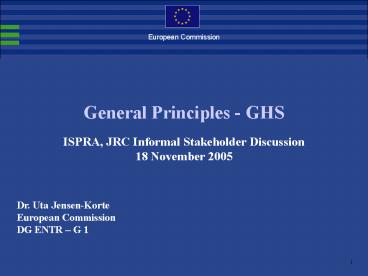European Commission PowerPoint PPT Presentation
1 / 15
Title: European Commission
1
European Commission
General Principles - GHS ISPRA, JRC Informal
Stakeholder Discussion 18 November 2005 Dr.
Uta Jensen-Korte European Commission DG ENTR G 1
2
General Principles
- GHS is a top down approach
- GHS provides common basis for classification for
all the different target audiences including
consumers, workers, transport and emergency
responders - GHS provides a single hazard communication
message for the different target audiences - GHS includes optionalities to facilitate
implementation, but a common approach applicable
for all sectors
3
General Principles
- GHS Optionality
- Building Block Approach
- Classification cut-offs for Mixtures
- Competent Authority Options
4
GHS Application
- Harmonisation of the application of the GHS
- GHS ST/SG/AC.10/30/Rev.1, 2005
- 1.1.3.1.1 The goal of the GHS is to identify the
intrinsic hazards found in a chemical substances
and mixtures and to convey hazard information
about these hazards. The criteria for hazard
classification are harmonised. Hazard statements,
symbols and signal words have been standardised
and harmonised and now form an integral hazard
communication system - Competent authorities will decide how to apply
the various elements of the GHS based on the
needs of the competent authority and the target
audience.
5
GHS Building Block Approach
- Building block approach
- GHS ST/SG/AC.10/30/Rev.1, 2005, 1.1.3.1.5
- Consistent with the building block approach,
countries are free to determine which of the
building blocks will be applied in different
parts of their systems . . . . While the full
range is available to everyone,., the full range
does not have to be adopted.
6
GHS - Building Block Approach
- Further clarification provided in
ST/SG/AC.10/C.4/2005/6 - - Proposal to be discussed at the Dec. 2005 UNSCE
GHS - 1.1.3.1.5.1 The selection of which hazard classes
and appropriate hazard categories for a
particular sector,, are at the discretion of the
CA.
7
GHS - Building Block Approach
- Further clarification provided in
ST/SG/AC.10/C.4/2005/6 - - Proposal to be discussed at the Dec. 2005 UNSCE
GHS - 1.1.3.1.5.2 There are two considerations to the
BBA - (a) Is each CA expected to adopt each GHS hazard
class? - No, not all hazard classes are applicable to all
target audiences/sectors. - (b) Is each CA expected to adopt each category
within each hazard class? - No. If the current regulatory approach within a
sector does not cover certain categories of lower
hazard within a hazard class, the GHS BBA allows
that sector to include only those categories
currently covered in their system
8
GHS - Building Block Approach
- ST/SG/AC.10/C.4/2005/6
- 1.1.3.1.5.3 it would be inconsistent with the
GHS to split or re-combine categories within a
hazard class - 1.1.3.1.5.4 Standardized label elements which
have been assigned to each category should be
used only for that specific category. - 1.1.3.1.5.5. Once a hazard class and category is
chosen by a sector and if that sector provides
hazard information for that particular hazard,
then the standardized GHS label elements would be
expected as part of GHS implementation
9
GHS - Building Block Approach
- ST/SG/AC.10/C.4/2005/6
- 1.1.3.1.5.6 At the CAs discretion, label
information can be based on risk rather than
hazard (see 1.4.10.5.5.2 CAs may authoriserisk
based labelling) - 1.1.3.1.5.7 As long as the hazards covered by a
sector or a system are covered consistently with
the GHS criteria and requirements, it will be
considered appropriate implementation of the
GHS....it is hoped that the application of the
GHS worldwide will eventually lead to fully
harmonised situation.
10
GHS Building Block Approach
Freedom to implement Examples
- hazard classes /or
- categories
- Transport
- no chronic hazard classes
- acute toxicity category 1to 3
- Supply use
- mild irritant category 3?
- acute toxicity category 5?
11
GHS Optionality
- Building Block Approach/Competent Authority
Options - Building Block Approach allows for inclusion or
exclusion of specific harmonised elements of GHS - If included, harmonised application of GHS
elements applies - Competent Authority Options allows for inclusion
of unharmonised GHS elements - If included, unharmonised elements applies
12
GHS Implementation
- Consistent implementation of the GHS
- At the structural/conceptional level the GHS
calls upon applying the principles of the GHS - At the level of individual elements e.g. choice
of hazard classes and/or categories the BBA
provides the lead structure - If a hazard class and/or category is chosen the
GHS rules apply - However GHS provides the possibility to include
hazards covered by national systems which are not
yet covered by the GHS - Consistency with transport needs to be ensured
13
GHS EU system
- GHS Hazard Classes
- 16 classes for phys-chem
- 10 classes for human health
- 1 class for aquatic environment
- EU classification as dangerous so called
categories of danger - 5 for phys-chem
- 9 for human health
- 1 for environment
- Plus special labelling provisions
14
GHS Implementation Conclusion
- The GHS with the BBA and some of the other
optionalities provides the possibility to
implement the GHS with a level of protection as
desired - higher or lower level than the existing EU system
- similar to the existing EU system
- The Commission White Paper WG recommended to
follow existing EU system as close as possible - The responses to the questionnaires circulated to
MS and other stakeholders May 2004 expressed a
similar view
15
Thank you!
For further information, please, consult the
website http//europa.eu.int/comm/enterprise/reac
h/ghs_en.htm

